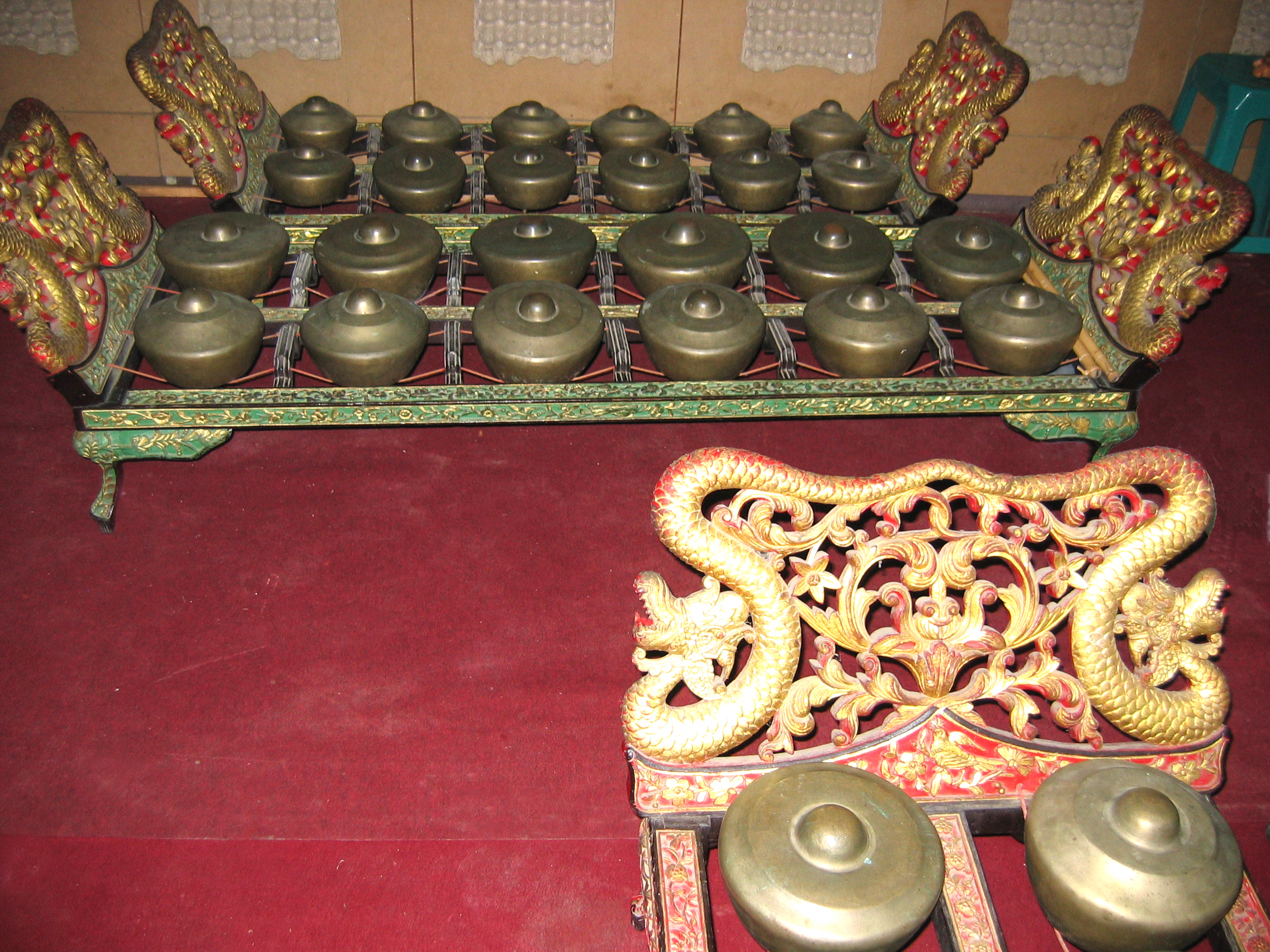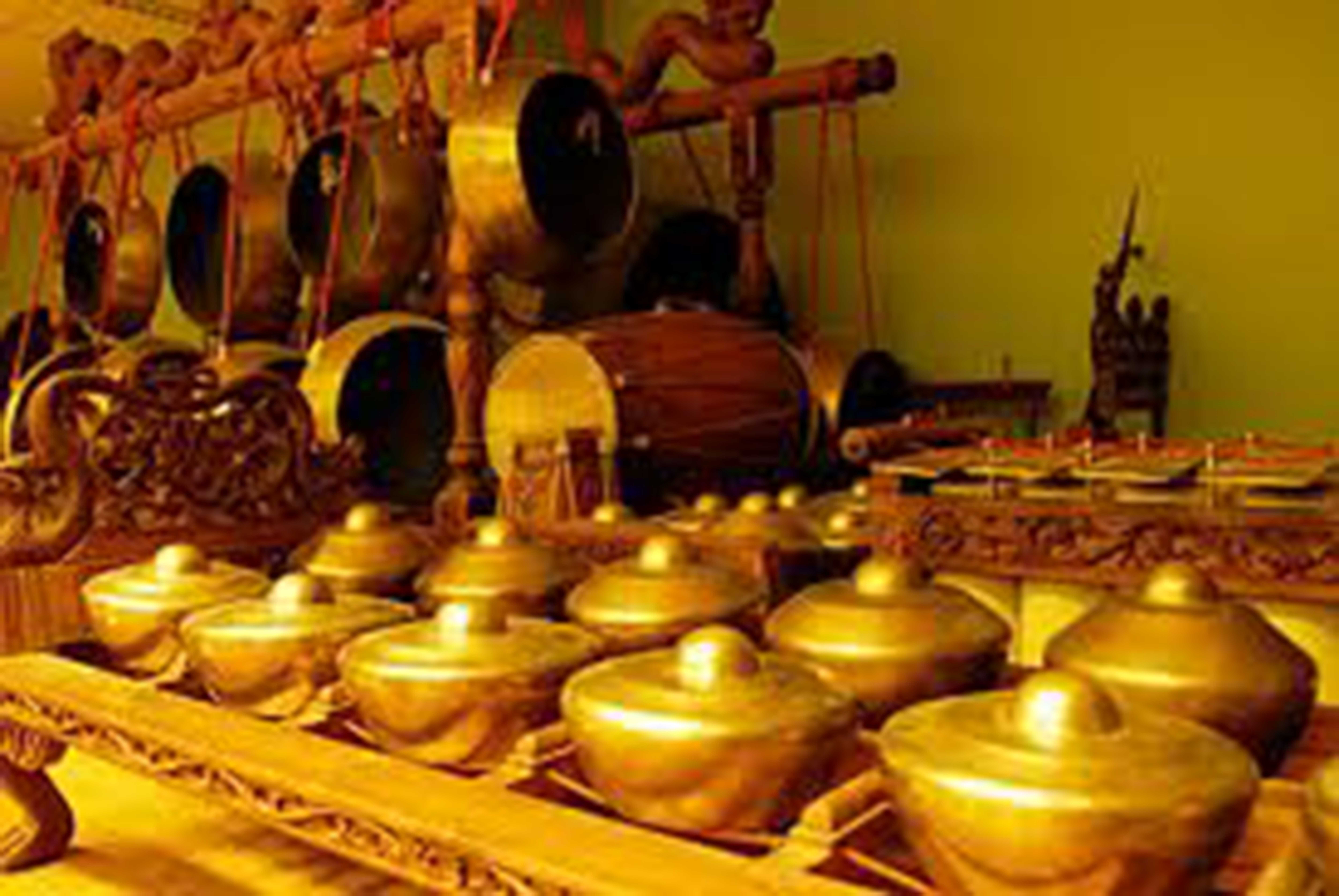|
Gong-chime
A gong chime is a generic term for a set of small, high-pitched bossed pot gongs. The gongs are ordinarily placed in order of pitch, with the boss upward on cords held in a low wooden frame. The frames can be rectangular or circular (the latter are sometimes called "gong circles"), and may have one or two rows of gongs. They are played by one to four musicians, each using two padded sticks to strike them. They are an important instrument in many Southeast Asian musical ensembles, such as Indonesian gamelan, kulintang, or Thai pi phat. For this reason, such ensembles are sometimes called "gong chime ensembles" or "gong chime orchestras," and the broad variety of music "gong chime music." Gong chimes typically are played either in a soloistic style, providing a virtuosic embellishing role, or providing a rhythmic role, for example, in a colotomic structure. The term may also be used to refer to hand-held tuned gongs played in high rhythmic density, such as the older Indonesian- Ba ... [...More Info...] [...Related Items...] OR: [Wikipedia] [Google] [Baidu] |
Kulintang
Kulintang ( id, kolintang, ms, kulintangan) is a modern term for an ancient instrumental form of music composed on a row of small, horizontally laid gongs that function melodically, accompanied by larger, suspended gongs and drums. As part of the larger gong-chime culture of Southeast Asia, kulintang music ensembles have been playing for many centuries in regions of the Eastern Indonesia, Southern Philippines, Eastern Malaysia, Brunei and Timor, Kulintang evolved from a simple native signaling tradition, and developed into its present form with the incorporation of knobbed gongs from Sundanese people in Java Island, Indonesia. Its importance stems from its association with the indigenous cultures that inhabited these islands prior to the influences of Hinduism, Buddhism, Islam, Christianity or the West, making Kulintang the most developed tradition of Southeast Asian archaic gong-chime ensembles. Technically, ''kulintang'' is the Ternate, Mollucas, Maguindanaon, Lumad a ... [...More Info...] [...Related Items...] OR: [Wikipedia] [Google] [Baidu] |
Gamelan
Gamelan () ( jv, ꦒꦩꦼꦭꦤ꧀, su, ᮌᮙᮨᮜᮔ᮪, ban, ᬕᬫᭂᬮᬦ᭄) is the traditional ensemble music of the Javanese, Sundanese, and Balinese peoples of Indonesia, made up predominantly of percussive instruments. The most common instruments used are metallophones played by mallets and a set of hand-played drums called '' kendhang/Kendang'', which register the beat. The kemanak (a banana-shaped idiophone) and gangsa (another metallophone) are commonly used gamelan instruments in Bali. Other instruments include xylophones, bamboo flutes, a bowed instrument called a ''rebab'', a zither-like instrument ''siter'' (in Javanese ensemble) and vocalists named '' sindhen'' (female) or ''gerong'' (male).Sumarsam (1998)''Introduction to Javanese Gamelan'' Middletown. Although the popularity of gamelan has declined since the introduction of pop music, gamelan is still commonly played in many traditional ceremonies and other modern activities in Indonesia, b ... [...More Info...] [...Related Items...] OR: [Wikipedia] [Google] [Baidu] |
Pi Phat
A ''piphat'' is a kind of ensemble in the classical music of Thailand, which features wind and percussion instruments. It is considered the primary form of ensemble for the interpretation of the most sacred and "high-class" compositions of the Thai classical repertoire, including the Buddhist invocation entitled ''sathukan'' ( th, สาธุการ) as well as the suites called ''phleng rueang''. It is also used to accompany traditional Thai theatrical and dance forms including ''khon'' ( th, โขน) (masked dance-drama), '' lakhon'' (classical dance), and shadow puppet theater. Piphat in the earlier time was called ''phinphat''. It is analogous to its Cambodian musical ensemble of pinpeat and Laotian ensemble of pinphat. Types of ''piphat'' The smallest ''piphat'', called ''piphat khrueang ha'', is composed of six instruments: '' pi nai'' (oboe); ''ranat ek'' (xylophone); ''khong wong yai'' (gong circle); ''taphon'' or other Thai drums; ''glong thad'', a set of two l ... [...More Info...] [...Related Items...] OR: [Wikipedia] [Google] [Baidu] |
Traditional Indonesian Instruments02
A tradition is a belief or behavior (folk custom) passed down within a group or society with symbolic meaning or special significance with origins in the past. A component of cultural expressions and folklore, common examples include holidays or impractical but socially meaningful clothes (like lawyers' wigs or military officers' spurs), but the idea has also been applied to social norms such as greetings. Traditions can persist and evolve for thousands of years—the word ''tradition'' itself derives from the Latin ''tradere'' literally meaning to transmit, to hand over, to give for safekeeping. While it is commonly assumed that traditions have an ancient history, many traditions have been invented on purpose, whether that be political or cultural, over short periods of time. Various academic disciplines also use the word in a variety of ways. The phrase "according to tradition", or "by tradition", usually means that whatever information follows is known only by oral tradition, ... [...More Info...] [...Related Items...] OR: [Wikipedia] [Google] [Baidu] |
Bonang
The bonang is an Indonesian musical instrument used in the Javanese gamelan. It is a collection of small gongs (sometimes called "kettles" or "pots") placed horizontally onto strings in a wooden frame (''rancak''), either one or two rows wide. All of the kettles have a central boss, but around it the lower-pitched ones have a flattened head, while the higher ones have an arched one. Each is tuned to a specific pitch in the appropriate scale; thus there are different bonang for pelog and slendro. They are typically hit with padded sticks (''tabuh''). This is similar to the other cradled gongs in the gamelan, the kethuk, kempyang, and kenong. Bonang may be made of forged bronze, welded and cold-hammered iron, or a combination of metals. In addition to the gong-shaped form of kettles, economical bonang made of hammered iron or brass plates with raised bosses are often found in village gamelan, in Suriname-style gamelan, and in some American gamelan. In central Javanese gamela ... [...More Info...] [...Related Items...] OR: [Wikipedia] [Google] [Baidu] |
Bianqing
The ''bianqing'' (Chinese: 编磬) is a traditional Chinese percussion instrument consisting of a set of L-shaped flat stone chimes known as ''qing'', played melodically. The chimes were hung in a wooden frame and struck with a mallet. Along with the bronze bells called ''bianzhong'', they were an important instrument in China's ritual and court music going back to ancient times. The instrument was imported to Vietnam (where it is called ''biên khánh''), and Korea (where it is called ''pyeongyeong''). In the 11th year of King Yejong of Goryeo (1116), it was imported from the Song Dynasty. It is still used in Korean court and ritual music. History The bianqing existed before Shang Dynasty. The bianqing in the Shang Dynasty are made of stone, jade and bronze. The tiger shaped stone bianqing unearthed from the Yin tomb in the village of Wu Guan in Anyang, Henan Province, is made of marble and has a history of more than 3000 years. Its timbre is as clear as that of bronze musica ... [...More Info...] [...Related Items...] OR: [Wikipedia] [Google] [Baidu] |
Lithophone
A lithophone is a musical instrument consisting of a rock or pieces of rock which are struck to produce musical notes. Notes may be sounded in combination (producing harmony) or in succession (melody). It is an idiophone comparable to instruments such as the glockenspiel, vibraphone, xylophone and marimba. In the Hornbostel-Sachs classification system, lithophones are designated as '111.22' – directly-struck percussion plaques. Notable examples A rudimentary form of lithophone is the "rock gong", usually a natural rock formation opportunistically adapted to produce musical tones, such as that on Mfangano Island, in Lake Victoria, Kenya. The Great Stalacpipe Organ of Luray Caverns, Virginia, USA uses 37 stalactites to produce the Western scale. Other stalactite lithophones are at Tenkasi in South India, and at Ringing Rocks Park in Pennsylvania. An example that is no longer used is at Cave of the Winds, in Colorado Springs. The Txalaparta (or Chalaparta), a tradition ... [...More Info...] [...Related Items...] OR: [Wikipedia] [Google] [Baidu] |
Bianzhong
Bianzhong (Chinese:编钟) is an ancient Chinese musical instrument consisting of a set of bronze bells, played melodically. China is the earliest country to manufacture and use musical chimes. They are also called Chime Bells. These sets of chime bells were used as polyphonic musical instruments and some of these bells have been dated at between 2,000 to 3,600 years old. They were hung in a wooden frame and struck with a mallet. Using a wooden hammer and a rod to beat the bronze bell can make different pitch. Along with the stone chimes called ''bianqing'', they were an important instrument in China's ritual and court music going back to ancient times. Several sets of ''bianzhong'' were imported to the Korean court during the Song Dynasty. Pronounced in Korean as pyeonjong, the instrument became an important part in Korea's ritual and court music and is still in use. In Vietnam, the instrument, which was used in ceremonies in the court at Huế, is called biên chung. The instr ... [...More Info...] [...Related Items...] OR: [Wikipedia] [Google] [Baidu] |
Degung
''Gamelan degung'' is a form of Sundanese musical ensemble that uses a subset of modified gamelan instruments with a particular mode of ''degung'' scale. The instruments are manufactured under local conditions in towns in West Java such as Bogor and Bandung. ''Degung'' music is often played at public gatherings in West Java, such as at local elections, as well as many other events. There is international interest in ''degung'' as well among communities in other countries interested in Indonesia and gamelan music.Dewi Anggraeni"Melbourne: Gamelan, elephants and 'Jackpot'" , ''The Jakarta Post'', 22 February 2004. Gamelan degung also playable in '' madenda'' scale, which included in the set as a complementary tone, usually marked as -3/''ni'' tone in the set. Playing gamelan degung in this scale requires the substitution of the 3/''na'' metal bars into -3/''ni'' tone on all instruments. Instruments The instrumentation of ''gamelan degung'' is quite flexible. It may include: ... [...More Info...] [...Related Items...] OR: [Wikipedia] [Google] [Baidu] |


.jpg)



